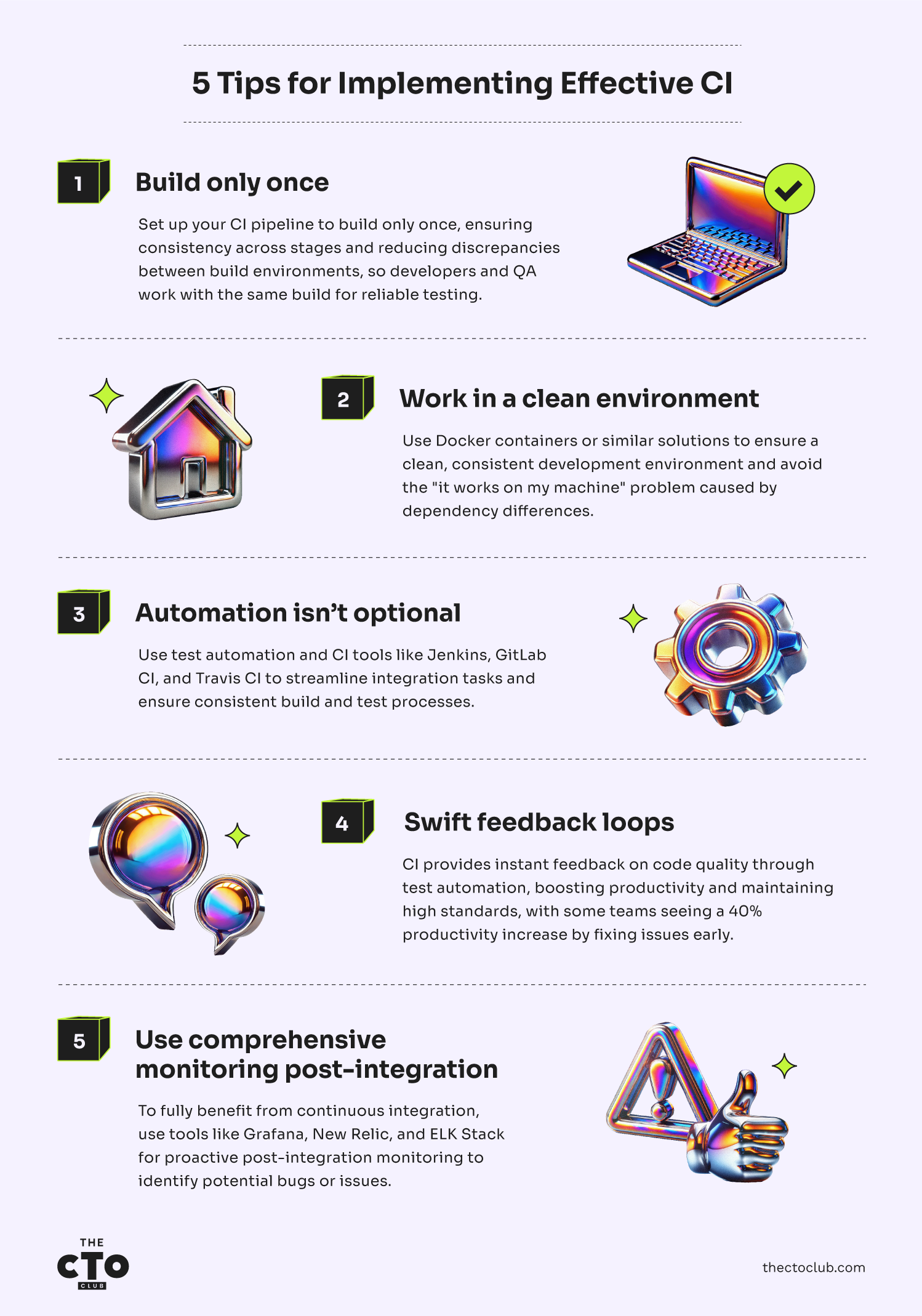Continuous integration (CI) is a practice in DevOps software development where developers frequently integrate their code updates into a central repository. This is followed by the automatic execution of builds and tests.
CI is changing the development process. When judiciously implemented, continuous development can help organizations become more efficient and develop software that is robust, reliable, and scalable.
In this guide, I’ll explore how CI can help teams write quality code and how you can use it to optimize your team’s development process.
What is Continuous Integration (CI)?
Continuous Integration (CI) can be defined as the practice of consistently and automatically merging code changes from multiple developers, subjecting it to automated builds and tests.
CI emerged as an improvement over traditional development practices, as development teams looked for ways to automate collaboration using a shared repository and the power of version control tools.
Why is CI Important?
CI helps teams overcome several challenges when developing large projects.
- Scalability: As projects grow and source code becomes longer and more complex, managing integrations manually becomes a monumental task.
- Maintainability: Ensures a maintainable codebase, reducing technical debt. As work is added to the code repository, automated unit tests are performed, giving peace of mind that the patches don’t add unforeseen issues.
- Improved Collaboration: CI ensures everyone is on the same page and that they’re writing quality code. It streamlines the release process and can help reduce "integration hell" scenarios, such as inconsistent interfaces and versioning issues. As an example, imagine teams designing their APIs in isolation. When the time comes for Team A to integrate with Team B, integration becomes difficult due to discrepancies in data formats.
- Improved Agility: Using CI allows teams to adapt to market changes swiftly by ensuring a continuously deployable codebase.
What are the Benefits of Continuous Integration?
Adopting continuous integration as a part of your development methodology can have several potential benefits. Suppose your organization has many developers working on different parts of a project. Continuous integration can streamline workflows, reduce integration conflicts, and ensure code quality, leading to faster releases and a more collaborative development environment.
- Reduced Lead Time: CI minimizes the delay between an initial code commit and its deployment as part of a version update or release. This helps your team release new software versions, security patches, bug fixes, and other updates more efficiently.
- Higher Code Quality: Constant automated testing gives developers continuous feedback, enabling quicker fault isolation and making it easier to produce quality code.
- Improved Developer Efficiency: By automating mundane tasks, CI allows your team members to focus on innovation, adding new features, or improving the core functionality of your product. If your team isn’t forced to sift through data or handle basic deployment tasks, they could focus on developing features that enhance user engagement to boost retention. For example, an e-commerce storefront could benefit immensely from a personalized recommendation tool tailored to unique users.
- Enhanced Collaboration: Making CI a part of your standard software development process encourages developers to submit new code to the code repository regularly and run frequent integration tests. This reduces the risk of issues arising on code integration.
- Potential Cost Savings: When your workflow includes CI, you’re more likely to spot integration issues early on. Your software development team can spend less time troubleshooting hidden issues and more on productive development.
- Increased Reliability: With automated testing, CI ensures your repository always contains a stable, ready-to-deploy software product.
- Improved Customer Satisfaction: Maintaining full test coverage and running automated tests maximizes stability and reduces the time required for each release, producing happier end-users.
5 Tips for Implementing Effective CI

1. Build only once
Configure your CI pipeline to ensure you build only once. This helps maintain consistency across all stages of the pipeline and reduces the risk of any discrepancies creeping in due to subtle differences between build environments.
If your developers and QA are working with the same build, bugs should be reproducible, and any behaviors being tested should be consistent.
2. Work in a clean environment
Always try to build/work in a clean environment to ensure consistent results. Consider using docker containers or a similar containerization solution for this exact reason.
One of the most common issues developers face is “it works on my machine,” which is caused by subtle dependency differences. A single, clearly defined development and testing environment helps prevent conflicts from previous builds and other difficult-to-diagnose build issues.
Many organizations have moved to docker, making it easier to share builds and get testing environments up and running.
3. Automation isn’t optional
Take advantage of test automation and other tools to remove human bottlenecks and ensure proper build and test processes are always followed. Whether you use Github, Codeberg, Gitlab, or a standalone Git installation, you can use CI tools to streamline your integration tasks. Some popular tools include Jenkins, GitLab CI, and Travis CI.
4. Swift feedback loops
CI makes it easier to gather metrics about your code as you work. Thanks to test automation, you get instant feedback on the quality of your code and can take steps to rectify issues immediately. This helps keep your developers as productive as possible and maintains a high standard of code quality.
Using CI/CD workflows has helped some teams we’ve worked for increase their productivity by as much as 40% as they took advantage of the real-time feedback to fix issues early on in the development lifecycle.
5. Use comprehensive monitoring post-integration
As with any other methodology, to truly take advantage of continuous integration, you need to engage in proactive post-integration monitoring. Tools like Grafana, New Relic, and ELK Stack can help your team identify potential bugs or issues, offering ongoing insights in an easy-to-digest format.
Continuously Integrate Like a Pro
Getting started with continuous integration can seem complex, especially if you’re not used to container management solutions, CI tools, and other tools that make up the CI pipeline.
It’s worth investing the time into building a sound CI system; however, in the long run, it’ll significantly improve the efficiency of your software development process, saving you time and money while improving the quality of your code.
Subscribe to The CTO Club newsletter for more industry news and discussions.







